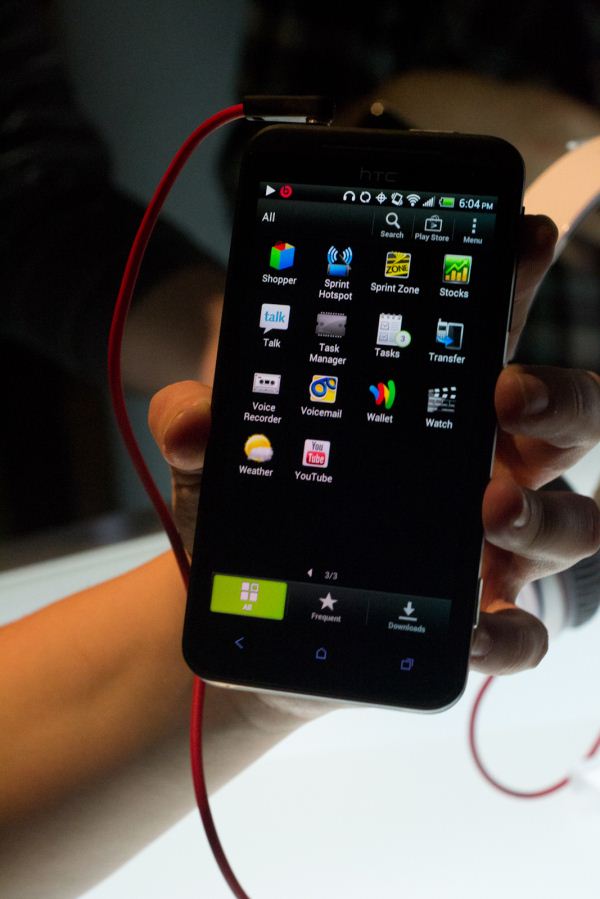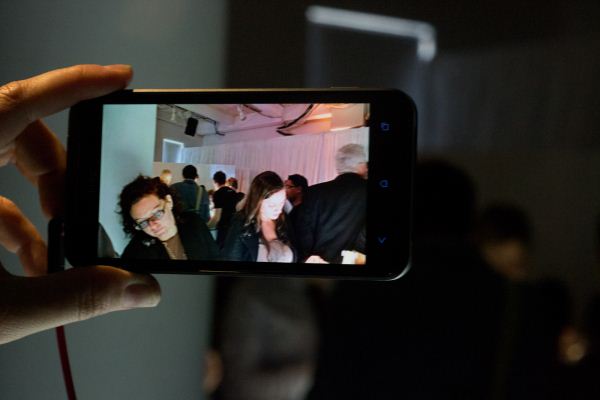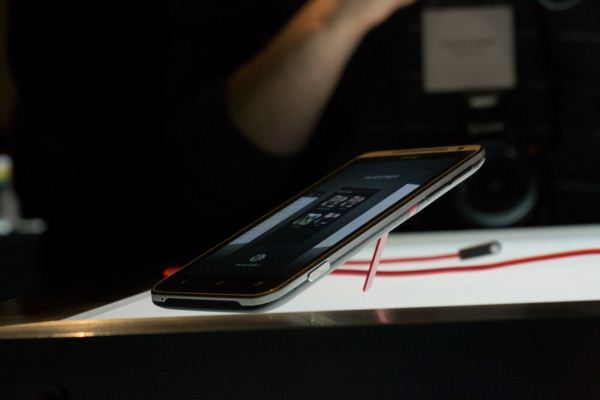HTC And Sprint Announce The EVO 4G LTE: Krait and LTE, on Sprint for $199 [Updated w/ Hands-on]
by Jason Inofuentes on April 4, 2012 5:29 PM EST- Posted in
- Laptops
- Snapdragon
- HTC
- Sprint
- Qualcomm
- LTE
- Smartphones
- Krait
- Mobile
- EVO 4G LTE
During the remarks HTC brought on Jonah Becker to discuss the design initiatives that went into creating this latest EVO device. Notably, the phone's chassis is anodized and chemically etched to create a black soft-touch surface. The edge of the phone is shaved to give it that silver rim, and the red-accent bits are also anodized aluminum. The matte finish over much of the phone is interrupted by the glossy upper portion of the back, which is a removable glossy black cover that provides access to the microSD card slot. The battery is inaccessible, a necessity in designing a phone this thin that doesn't use an AMOLED display.
In the hand the phone feels light, and comfortable, though the soft surfaces give me the fear I'm going to drop it any second. The size of the device doesn't feel overwhelming, a fact that's helped by the narrow bezels on the sides of the screen. The screen looks fantastic, and viewing angles are good at 160 degrees, though there was some color distortion at those extremes. I am still surprised to see capacitive buttons on ICS devices, though I suspect they will remain featured on lots of devices, long after this one. The dedicated shutter is an aluminum piece that feels solid and easy to actuate without rocking the device. The volume rocker is a little less compelling as it matches the glossy rear cover and feels a little squishy.
The software feels snappy and responsive; HTC's Sense 4.0 is still the Sense we know and love/hate, but apparently less intrusive. I say apparently because the hallmarks of Sense are all still there. The prominent clock and weather widget is updated with the Roboto font. The dock still retains four customizable apps along with the app drawer. The lock screen still features a ring that can be used to unlock the phone or activate one of four customizable apps. Indeed, there are few areas that seem to be untouched. Even the app switcher has been rejiggered with a WebOS-like card interface, set as a 3D carousel. So, this isn't vanilla Android, but it doesn't seem to be slowing the device down.
As we mentioned in the overview, the camera received special attention, both here and on the entire One line. HTC's ImageSense branding represents the f/2.0 lens and the imaging ISP they've included. With all that, HTC has once again put their mark on the camera interface, including a continuous shot mode (4 stills per second, up to 90 seconds) and is activated by simply holding the shutter down. An HDR mode is included along with the typical panorama and scene modes. The 8MP pixel sensor is capable of shooting 1080P video, and in this implementation is actually taking near continuous 5MP stills so still shots can still be taken while shooting video. In practice, the images look good, when we get a device in for review we will be excited to dig deeper and see just what magic HTC has dug up for their imaging ISP.
A long line formed in front of a pair of sound proof booths that HTC and Sprint set-up to demonstrate their HD Voice implementation. As Brian mentioned, the use of EVRC-NW will greatly improve the frequency response of Sprint's voice calls, though still falls short of providing the full range of the human voice. We can expect more of these sorts of announcements from all the major US carriers in the near future, making our analysis of noise cancelation and voice quality all the more pertinent. Improved vocoders help not at all if what's transmitted is still noisy and garbled.
And then there's the kickstand. I've been a fan of the idea on consumer electronics devices since the first time I saw someone trying to watch a video on a 5th generation iPod. The particular design used on this EVO is a little stiff to deploy, but once out can be positioned in two different landscape angles, and in portrait. Portrait seems handy for video chat, and the two different landscape position can be useful when on flights with an awkwardly positioned tray table. The kickstand itself feels incredibly solid and would likely require a good bit of force to break.
All told, during our short time with the device, it felt good in the hand, and as smooth as we'd expect a Krait device to feel. Now comes the waiting game. Pre-orders start on 5/7, painting a picture that puts this phone available late in the second quarter of 2012. Enjoy the gallery and feel free to send any questions our way.














22 Comments
View All Comments
vertigo_2_20 - Thursday, April 19, 2012 - link
Agreed. I bought spare batteries for my EVO 4G and although I rarely have the need, it's nice to be able to swap out and be charged up and ready to go. Also, I prefer the SD card to be safely stowed away inside the phone, although ideally not to the point the battery has to be removed to get to it, but I realize that might be asking too much. Also, why do phone manufacturer's keep thinking that the side of the phone is a good location for the charging port??TBH, I don't know if I'll ever buy another HTC phone again after my experiences with the Hero and the EVO 4G. This company has shown very clearly that they couldn't care less about the consumer post-purchase, and they don't stand behind their products and ditch support for them very quickly, so they can create and sell 20 new models.
ChoadNamath - Thursday, April 12, 2012 - link
I know you're not going to get any concept of its battery life in a limited hands-on session, but I'm curious how good/bad it will be with this phone. I gave up on my EVO 4G because of its absolutely awful battery life -- even with the 4G radio always off. That seems to be a recurring problem with Android phones; as much as I love them in theory, I need a phone that can last a whole day without having to top off the battery.